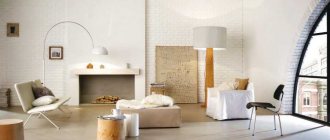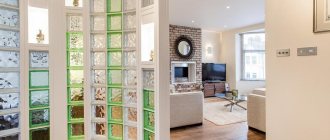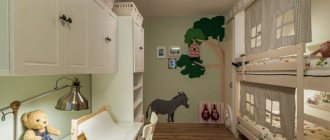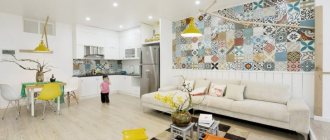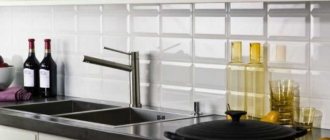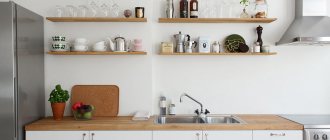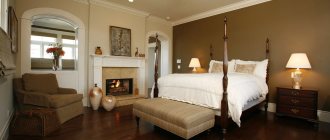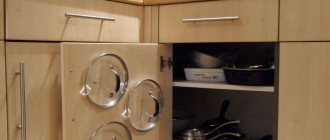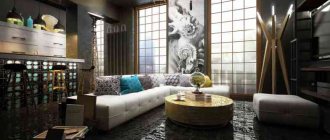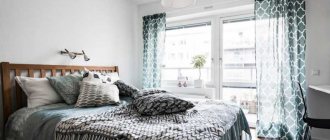Advantages and disadvantages
Before we look at all the advantages and disadvantages, we should define the concept itself.
Carpet is a rolled floor covering with pile of various lengths. The main differences from the carpet: it has an unlimited length, is laid along the entire length and width of the room, the pattern is most often small, repeating (pattern). Pros of carpet:
- Universal. There are a large number of models on sale, differing in color, pattern, and pile length: you can find one that suits any style.
- Soft to the touch. When there are small children in the house, you don’t have to worry about them playing on the floor. And adults will also enjoy walking on such a surface.
- Long lasting. Carpeting in apartments began to be laid later; initially the material was intended for decorating lobbies, corridors and foyers in hotels and public institutions.
- Eco-friendly. Suitable for use in children's and adult bedrooms.
- Insulating. The carpet not only absorbs extraneous noise, but is also an excellent heat insulator: walking on a heated floor is pleasant even barefoot.
- Easy to install. To lay it in your apartment, you don’t have to call a specialist: having certain knowledge, you can do it yourself.
- Inexpensive. The minimum price per square meter is about 260 rubles, which is 2 times cheaper than the cost of laminate.
The photo shows a light carpet in the attic interior
Disadvantages of carpeting:
- Difficult to care for. Compared to linoleum or laminate, cleaning requires more effort and time: the main debris is removed with a vacuum cleaner, and dirt will have to be additionally cleaned with a brush.
- Permeable to moisture. The carpet itself is not destroyed by water, but dampness passes through it to the base, which can lead to the appearance of fungus.
- Easily soiled. Staining, especially on light-colored flooring, is easier than you think. Be prepared to stock up on an arsenal of special tools and use them constantly.
- Dust-retaining. Any carpet is a dust collector - so if there are allergy sufferers in the family, it is better to avoid fleecy surfaces.
The photo shows the carpet in the children's room
Basis for carpet production
The carpet in the room, a photo of which can be seen on the website, is made from various materials. To create the bases, the following raw materials are used:
- latex, rubber (it is durable and helps the product retain its shape and is easy to clean and wash, it is pleasant to walk on, and the product can withstand various loads);
- felt of artificial origin guarantees the final product resistance to moisture and ease of cutting and covering; there is impregnation to repel dirt; the pile itself has thermal insulation properties;
- jute (the base of this material is nothing more than an interweaving of several threads; it is used for contact-type coatings and is convenient and also clean from an environmental point of view);
- foam base (it is as natural as possible and is distinguished by the properties of softness and elasticity, the material provides comfortable walking and is easy to wash, but wear occurs quickly).
The stronger and more expensive the base, the higher the cost and service life of the material.
Types and characteristics
According to the method of production, carpets are distinguished:
- Tufted. It is made by punching needles with wool into the warp and forming loops from them. The technology makes the carpet rigid, but allows you to create multi-level patterns and achieve different effects by varying the depth of the pile, cutting it or leaving it whole.
- Woven. The weft and warp threads are intertwined, which makes it possible to obtain a durable, wear-resistant material.
- Needle-punched. The process is reminiscent of felting - barbed needles pull the wool back and forth, forming a dense surface. It is inferior to the first two types in beauty, but is distinguished by increased wear resistance and noise insulation characteristics.
The pile happens:
- Natural. Made from wool, cotton, linen, sisal. Almost no chemicals are used in production, so the cost is higher than synthetics. The solution is suitable for living rooms not only because of its environmental friendliness, but also due to its ability to maintain a microclimate: the fibers absorb excess moisture, and when the air becomes dry, they begin to release it.
- Synthetic. The flooring is made from polyacrylic, polyamide, and polyester threads. Their price is justifiably lower, but their resistance to stains is better: the surface can be washed and most stains can be easily removed from it.
Based on the base material, they are distinguished:
- Felt. Does not rot, suitable for wet cleaning.
- Textile. Withstands dry cleaning only.
- Rubber. Not afraid of water, but takes a very long time to dry.
- Latex. It takes a long time to dry like rubber. After 5-7 years of use it may begin to crumble.
The last difference between carpet is the scope of application:
- Domestic. Soft pile at the same time allows you to walk in socks or barefoot and complicates the maintenance process.
- Commercial. Coarser pile (designed for walking in shoes), restrained range of shades. Easier to care for. The cost is higher than household.
Nuances of the production process
The technique is quite complex; it is presented in several variations. Operating parameters are traditionally determined by the following factors:
- method of producing the material;
- raw materials used as a base;
- pile type and height;
- type of weaving;
- dyeing method.
Depending on the place of production, flocked, tufted, needle-punched and woven versions are distinguished. The latter type of raw material is quite complex, but it lasts for a long time. When using it, individual strands of pile are intertwined, and a so-called “cobweb” is formed, which is subsequently strung onto the lining and covered with latex from the inside out. This process is mechanized, however, it is completely problematic to implement it.
As for flocked carpet, it does not allow water to pass through. The base for its production is PVC, the length of the pile is 3 mm. The raw materials are used in rooms that are characterized by high humidity and there is a need for frequent cleaning.
Tufting material is made on the basis of latex; it is a coating consisting of several levels, which gives it a three-dimensional image. It is obtained by “sticking” a thread into the base and securing it with glue. The material has decorative functions and is difficult to clean.
The needle-punched type of fabric is produced by repeatedly punching the fibrous base using special needles, that is, it is like “driving” the pile into the base. Such raw materials are produced using a rubber or latex lining. The result is felt fabric, with no high pile.
Selection rules
What kind of carpet to lay depends on the functional purpose of the interior.
Living room
Tufted or woven carpets with high pile will create home comfort. Feel free to use design techniques like bright colors or printed patterns.
The photo shows carpet laying in a single contour
Bedroom
Eco-friendly natural material will fit into rest rooms, but for allergy sufferers it is better to choose short-haired artificial materials.
Children's
The recommendations are the same as for the bedroom: the floor in a small child’s room should not cause allergies, but remain pleasant to the touch and suitable for playing.
Hallway
The corridors are highly trafficked and dirty. In the area of the front door it is better to abandon it in favor of practical tiles. In the rest of the room, lay a commercial or durable household option.
Linoleum or carpet?
We have already written about the choice between linoleum and carpet. In the case of the bedroom, it is worth noting that linoleum will not give you the comfort and relaxation that the soft pile of carpet provides.
Design options and colors
In the design of residential premises, carpet in light basic shades is mainly used - gray, beige. But the shade options are almost endless (especially for synthetic pile carpet).
Achromatic black, white or bright peach, lemon, green, blue, red - everyone will find a suitable option for themselves.
Carpet for children's rooms is often produced with a pattern: geometric, animalistic, floral. There are also images of entire cities with houses and roads.
Important! When choosing models with a pattern, remember: carpet in the interior will last at least 10 years. Are you ready to see just such a floor every day during this time?
Product coloring option
Before studying a photo of carpet , you should familiarize yourself with the types of its dyeing, because this characteristic is important and affects the degree to which the product retains its beautiful shade and presentable appearance. In general, three types of coatings can be distinguished:
- carpet made of colored pile or synthetics, which is dyed, this option is quite expensive, but the dyeing is organized right down to the very base, and there is no shedding or fading with burnout;
- carpet with dyeing of finished threads, which are subsequently used to weave the covering;
- carpet with pigment applied on the basis of stencils, in this case the pile is not dyed to the base, the coating quickly wears off.
Each consumer decides independently which option to choose.
Care instructions
A cozy floor covering needs 2 types of cleaning: regular and deep.
- Clean the floor at least once a week with a vacuum cleaner (it is better to use a special turbo nozzle with a rotating brush). It removes dust and refreshes the appearance.
- Once every 1-3 months (depending on the condition of the surface), deep dry cleaning is carried out. To do this, you should purchase a special carpet powder. It is distributed over the carpet, wait the time indicated on the package, and collect it with a vacuum cleaner.
Special attention is paid to the stains that have formed: they need to be removed from the carpet as quickly as possible so that the dirt does not have time to dry. The problem of fresh dirt will be solved by the same deep cleaning powder or a special stain remover.
Are there any disadvantages and what are they?
This type of raw material is characterized by the following disadvantages:
- there is a possibility of an allergic reaction;
- the capriciousness of some types of coatings in terms of the use of detergents;
- electrification of some materials;
- lack of “tolerance” to a humid environment;
- the likelihood of insects appearing in piles that have not been treated with impregnation;
- fading of paint over time due to exposure to the sun's rays;
- the need for frequent cleaning;
- ability to absorb odors.
Despite the disadvantages, the advantages are significant, which is why the material is popular among people of different preferences and income levels.
0
How does it look in the interior?
Designers and home owners still do not have a common opinion about carpet: some consider it outdated and impractical, others consider it stylish and cozy. But the fact remains: the scope of application of rolled carpets is wide, and the service life depends more on the quality of the surface itself than on its care.
The photo shows high-pile carpet
If you look at photographs of foreign interiors, you will notice that in most rooms there is carpet.
The photo shows a variant of a neutral pattern for a nursery
In Russia it is used less often, but if you have helpers around the house (for example, a robot vacuum cleaner), you definitely shouldn’t be afraid: with proper care, it will retain its original appearance for many years.
Before purchasing, evaluate all the pros and cons of the carpet, carefully study the composition - only then make a decision about payment.
How to choose?
Before you go shopping, it is recommended to follow the advice of experienced designers. They tend to work most often with different types of flooring.
- Welding work of any complexity from a company in Moscow
- Ceramic tiles are a modern choice for renovation!
- High-quality living room renovation of any complexity from professionals
What to consider when choosing your favorite model? The main subtleties of choice include:
- ease of care. Here it is best to give preference to carpet with small, fluffy pile;
- The density of the carpet should be medium;
- textile fibers are too long and quickly lose their original appearance;
- models with synthetic materials have a long service life. The composition may contain natural wool, which will add softness to the flooring;
- Before choosing, pay attention to the quality of coloring materials. The thread should be dyed from the very top to the bottom. If it is half painted, then you have a low-quality carpet.
Choosing the right model for the living room is quite simple. The main thing here is to take into account the characteristic features of the carpet.
